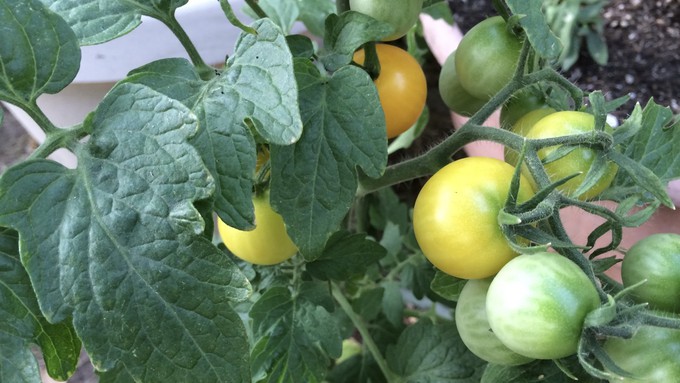
Yolo master gardeners present an online and in-person chat

So the tomatoes are starting to grow -- and the pests appear. Kathy Morrison
The tomatoes are finally in the ground, growing and even setting fruit. Then the pests start to appear, especially the dreaded tomato hornworm. Or the tomatoes develop brownish spots on the bottom -- blossom end rot!
What's a tomato grower to do?
Certainly, prevention and awareness are keys to keeping those tomatoes from harm. At 10 a.m. on Saturday, June 3, in a hybrid in-person and Zoom online event, the Yolo County master gardeners will present their lastest Kitchen Garden Chat on this topic and more.
"We will talk about what to do in the edible garden with emphasis on pests and tomato issues and how to store the summer bounty," say the organizers.
The in-person event will be in the Leake Room of the Woodland Public Library, 250 First St., Woodland. To view the chat via Zoom, go to https://ucanr.zoom.us/j/98028723763. The event is free and open to all.
In addition, if you happen to be at the Woodland farmers market Saturday morning, starting at 9 a.m. the Yolo master gardeners will be staffing a table. Bring gardening questions and plant problems to them for potential solutions.
Looking ahead, an in-person workshop on "Gardening for Year-Round Meals" will be presented by the Yolo master gardeners on Saturday, June 10, at 11 a.m., United Methodist Church/Grace Gardens, 1620 Anderson Road, Davis.
For more on these events, check the Yolo MGs' Facebook page: https://www.facebook.com/yolomg.
For general information on the UCCE master gardeners of Yolo County, visit https://yolomg.ucanr.edu/
Comments
0 comments have been posted.Sacramento Digs Gardening to your inbox.
Food in My Back Yard Series
April 1: Don't be fooled by these garden myths
March 25: Fertilizer tips: How to 'feed' your vegetables for healthy growth
March 18: Time to give vegetable seedlings some more space
March 11: Ways to win the fight against weeds
March 4: Potatoes from the garden
Feb. 25: Plant a fruit tree now -- for later
Feb. 18: How to squeeze more food into less space
Feb. 11: When to plant? Consider staggering your transplants
Feb. 4: Starting in seed starting
Sites We Like
Garden Checklist for week of March 30
Your garden doesn’t mind April showers. Get busy now to enjoy those future flowers.
* Get ready to swing into action in the vegetable garden. As nights warm up over 50 degrees, start setting out tomato, pepper and eggplant transplants.
* From seed, plant beans, beets, cantaloupes, carrots, corn, cucumbers, melons, pumpkins, radishes and squash. (Soak beet seeds overnight in water for better germination,)
* Plant onion sets.
* In the flower garden, plant seeds for asters, cosmos, celosia, marigolds, salvia, sunflowers and zinnias.
* Transplant petunias, zinnias, geraniums and other summer bloomers.
* Plant perennials and dahlia tubers for summer bloom.
* Transplant lettuce and cabbage seedlings.
* April is the last chance to plant citrus trees such as dwarf orange, lemon and kumquat. These trees also look good in landscaping and provide fresh fruit in winter.
* Smell orange blossoms? Feed citrus trees with a low dose of balanced fertilizer (such as 10-10-10) during bloom to help set fruit. Keep an eye out for ants.
* Apply slow-release fertilizer to the lawn.